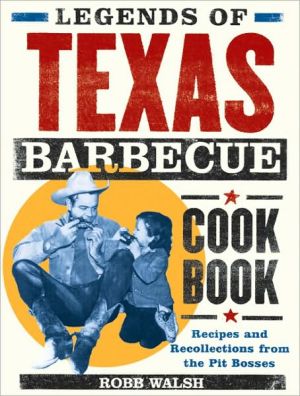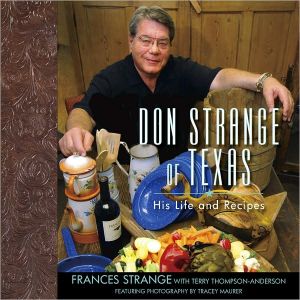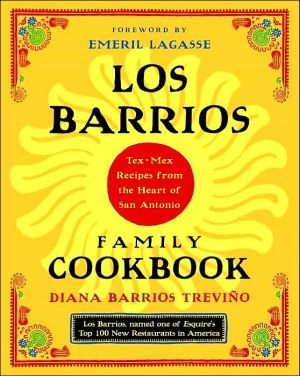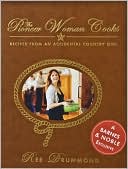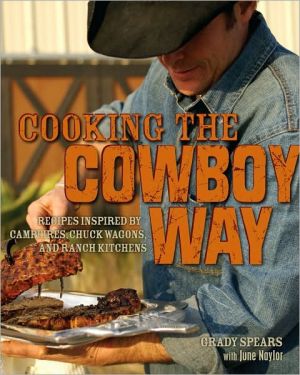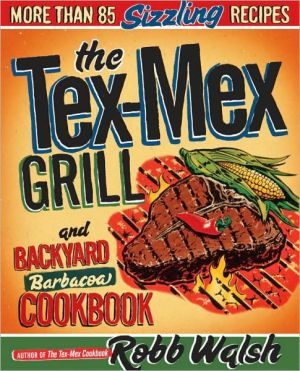Legends of Texas Barbecue Cookbook: Recipes and Recollections from the Pit Bosses
Welcome to Texas barbecue. They love to make it. They love to eat it. And they love to argue about it-igniting as many feuds as fires from Houston to El Paso. Legends of Texas Barbecue Cookbook delivers both a practical cookbook and a guided tour of Texas barbecue lore, giving readers straightforward advice right from the pit masters themselves. Their time-honored tips, along with 85 closely guarded recipes, reveal a lip-smacking feast of smoked meats, savory side dishes, and an awesome array...
Search in google:
Welcome to Texas barbecue. They love to make it. They love to eat it. And they love to argue about it-igniting as many feuds as fires from Houston to El Paso. Legends of Texas Barbecue Cookbook delivers both a practical cookbook and a guided tour of Texas barbecue lore, giving readers straightforward advice right from the pit masters themselves. Their time-honored tips, along with 85 closely guarded recipes, reveal a lip-smacking feast of smoked meats, savory side dishes, and an awesome array of mops, sauces, and rubs. Their opinions are outspoken, their stories outlandish and hilarious. Fascinating archival photography looks back over more than 100 years of barbecue history, from the first turn of the century squirrel roasts to candid shots of Lyndon Johnson chowing down on a plate of ribs. A list of the best barbecue joints and a month-by-month rundown of the most influential statewide cook-offs round out this glorious celebration of barbecue found deep in the heart of Texas. Publishers Weekly Not every cookbook would include a recipe that begins, Dig a pit 3-feet-deep, 4-feet-wide, and 40-feet-long. But this is Texas and, given 300 pounds of brisket, there is no more invigorating an experience than this kind of open pit barbecuing as championed by Walsh in his collection of barbecue memoirs, trivia and history. A newspaperman at heart, Walsh interviews the top pit bosses across the state and shares their secrets: Harley Goerlitz instructs beginners on a simple Pork Shoulder while Bubba Hodges offers Egypt Brisket with a mop sauce of vinegar, ranch dressing and Lone Star beer. For the politically astute, there are Barbecue Sauce offerings from both Lady Bird Johnson and Barbara Bush, not to mention Senator Lloyd Bentsen Highway Rice Salad, a democratic blend of Texmati rice, chopped vegetables, yogurt, pecans and cilantro. Most interesting is the exploration of cultural influences across the prairie, including a surprising look at the German and Czech political radicals who landed in Texas in the mid-1800s, and the smoked meats they brought with them. For those who prefer motoring to grilling, Walsh includes a fine list of barbecue joints all along the Barbecue Belt, as well as different meat markets and a calendar of some of the major cook-offs held throughout the state. Copyright 2002 Cahners Business Information.
LEGENDS OF TEXAS BARBECUE COOKBOOK\ Recipes and Recollections from the Pit Bosses\ \ \ By Robb Walsh\ \ Chronicle Books LLC\ Copyright © 2002 Robb Walsh.\ All rights reserved.\ ISBN: 0811829618\ \ \ \ \ Chapter One\ \ \ The pitmaster squints into the smoke as he opens the giant steel door. From your place in line, you watch him fork and flip the juicy, black beef clods and sizzling pork loins. Your heart beats faster as he opens a steel door to reveal a dozen sausage rings hissing and spitting in the thick white cloud. Slowly, the sweet cloud of oak smoke makes its way to you, carrying with it the aroma of peppery beef, bacon-crisp pork, and juicy garlic sausage. Your mouth starts watering. You swallow hard. Your stomach rears back and lets out a growl. You're in a frenzy by the time you get to the head of the line, where the hot meats are being sliced and weighed. You order twice as much as you can eat. You carry it away on a sheet of butcher paper, with an extra sheet tucked underneath for a plate.\ Welcome to Texas barbecue.\ We love to eat it. We love to make it. And we love to argue about it. We have competing theories on the etymology, the definition of the word, and on those characteristics that make it uniquely Texan. We don't agree on the kind of wood, the need for sauce, the cut of meat, or which part of the state does it best. And we all have our favorite pit bosses. But we all agree that non-Texans don't understand it.\ Traditional barbecue definitions don't make sense here. "Barbecue is always served with a distinctive sauce," say some. Not in Texas—some of our most famous barbecue joints serve no sauce at all. "Barbecue means slow cooking over the low heat of a wood or charcoal fire," say others. Sorry. Some of the best smoked meat in the Lone Star State is cooked at 600°F.\ So what is Texas barbecue exactly?\ If we can't quite agree on what it is, at least we can agree on where it came from. A look at the history of barbecue and the evolution of the modern barbecue pit explains a lot about our various styles.\ If you include roasting meat on an open fire in your definition of barbecue, then the earliest Texans to barbecue were the Caddo Indians, who cooked venison and other game here ten thousand years ago. They were followed by the Spanish shepherds, who spit-roasted kid goat and lamb al pastor ("shepherd style") on the South Texas plains, starting in the 1600s.\ The old Southern version of pit barbecue, meat cooked on a grate of sticks over hot coals in a hole in the ground, migrated to Texas from the South in several stages beginning in the early 1800s. Settlers used this open pit method to cook squirrels and venison. Mexican barbacoa, meat sealed in maguey leaves and buried in hot coals, has also been seen along the Rio Grande Valley for at least a hundred years.\ Old World meat smoking was brought to Central Texas by German and Czech butchers during an era of intense European migration that began in the 1830s and reached its height around 1890. The German meat markets sold fresh meats and smoked their leftovers in enclosed smokers, as they had done in the Old Country. They were probably astonished when migrant farm workers began the tradition of eating that smoked meat on the spot. The old meat markets are now considered by some to be quintessential Texas barbecue joints, despite the fact that German smoked meats and sausages aren't really American barbecue.\ When Texas entered the Union as a slave state in the 1850s, cotton planters from the Carolinas, Alabama, and Mississippi came to take advantage of the cheap land prices. Each plantation founder brought as many as a hundred slave families with him. When the slaves were freed in 1865, the African-American barbecue of East Texas became a style of its own.\ According to Eats: A Folk History of Texas Foods, the first big civic barbecues began to be held around the state in the early 1800s. Pits were typically 25 feet long and 3 feet across. Whole sheep, goats, pigs, and Steer's were cut into pieces and cooked over oak or hickory coals while being continuously basted. The standard cooking time was twenty-four hours.\ After the Civil War, beef became the meat most characteristic of Texas barbecue. In the days before refrigeration, barbecuing beef meant getting enough people together to make killing a whole steer worthwhile. When that happened it was quite a party. While the ultimate in Southern barbecue was cooking a whole hog, cooking a whole steer was the ultimate in Texas barbecue.\ Because you could feed so many people with a whole steer, Texas barbecues started out big—and then they got bigger. Texans being Texans, barbecues became competitions, and each barbecue became an effort to outdo all others. This tradition lives on in such events as the XIT Annual Reunion in Dalhart, where tens of thousands of people gather year after year to attend the "world's largest free barbecue."\ \ \ LEGENDS\ \ Civic Barbecues\ Big public barbecues were held for all kinds of reasons throughout Texas history. In fact, no civic celebration was complete without one.\ 1853 Stafford gave away free barbecue to the public to celebrate becoming a stop on the Buffalo Bayou, Brazos, and Colorado Railway.\ 1860 Sam Houston spoke at the "Great American Barbecue," a political rally thrown by the American Party in Austin. All citizens of the state were invited to attend and eat for free.\ 1891 The citizens of Whitney, a town with a declining population, held a barbecue to promote the benefits of citizenship. They gave away 3,500 pounds of barbecue.\ 1926 Edgar Byram Davis closed what was probably the biggest oil deal in the state up to that time. He got $12 million (half of it in cash) for his Luling oil holdings, and to celebrate he held a free barbecue. Attendance estimates run as high as thirty-five thousand.\ 1941 At his inauguration celebration, Governor W. Lee "Pappy" O'Daniel set up pits on the grounds of the capitol building in Austin and gave away barbecue to all corners.\ 1964 President Lyndon Johnson hosted the president-elect of Mexico at a state dinner at the LBJ Ranch in Johnson City. Catered by Walter Jetton, this dinner for 250 is reported to be America's first official barbecue state dinner.\ 1991 The XIT ranch's annual reunion in Dalhart, cooked eleven thousand pounds of beef in pits dug with backhoes. The meat was served to twenty thousand guests.\ \ \ The Barbecue Barons\ WALTER JETTON OF FORT WORTH WAS THE LAST OF the open pit barbecuers and probably the single most influential pit boss in Texas barbecue history. In the 1950s, Jetton held the record for barbecue catering, having fed twelve thousand people at one event. He also enjoyed considerable prestige as LBJ's favorite caterer. In 1965, Pocket Books published his LBJ Barbecue Cookbook.\ Walter Jetton was a traditionalist and a purist. He dug pits in the ground, burned hardwood down to hot coals, and cooked meat directly over the coals for eighteen to twenty-four hours. Jetton dismissed modern barbecue equipment as claptrap. Unfortunately, cooking in a hole in the ground is frowned on by health inspectors these days.\ County health departments regulate the use of barbecue pits in food service operations in Texas. The regulations, and how strictly they are enforced, have varied widely from county to county since the laws first hit the books during the health and sanitation crusades of the Progressive Era, in the early 1900s.\ The brick smokers of German-belt meat markets offered a design model for other barbecue restaurants. Built over a hundred years ago, some of these pits still provide us with insights into how to set up a barbecue. Some barbecue joints, such as Green's in Houston and Novosad's in Halletsville, built cleverly designed pits with the cooking chamber indoors and the firebox outdoors.\ Some cookbook authors have assumed that the pits in Texas barbecue restaurants were designed to replicate the slow cooking over hot coals common in traditional pit barbecue. But that isn't always true. The heat of Kreuz's old smoker has been measured at temperatures as high as 600°F. When Texas barbecue moved from the hole in the ground to the restaurant kitchen, the smoking process was speeded up.\ \ \ LEGENDS\ \ Linguistic Lore\ BQ\ Some pretty fantastic etymologies for the word "barbecue" have been advanced over the years. Two cookbooks I've seen recount a tale about a wealthy Texas rancher who fed all his friends whole sheep, hogs, and cattle roasted over open pits. In one cookbook his name is Bernard Quayle, in the other it is Barnaby Quinn, but in both versions the branding iron of the ranch has his initials B. Q. with a straight line underneath. Texas ranches are named for their brands, and a straight line is called a bar. Thus, the "bar B.Q." became synonymous with fine eating—or so the story goes.\ \ \ LEGENDS\ \ Linguistic Lore\ BABRACOT\ According to the Oxford English Dictionary, the English word "barbecue" derives from the Spanish word barbacoa, which is in turn a variation of babracot, a word that comes to us from the Haitian Taino dialect of the Arawak-Carib language. The Taino word babracot was a noun that actually meant the framework of green sticks that formed the grill.\ The Caribbean style of slow smoking on a grate over coals was brought to the Carolinas by African slaves in the 1600s and became the basis for the Southern style of barbecue. Advocates of open pit barbecue once argued that this was the only true barbecue style. Nowadays, however, German-style meat smoked in an enclosed pit, Mexican cabrito al pastor roasted by an open fire, and ribs grilled over direct heat all fall within somebody's definition of Texas barbecue.\ All Texans agree, however, that hamburgers and hot dogs are not barbecue.\ \ \ Mechanization\ IN 1949, A HOUSTON MACHINIST named Leonard O'Neill won a tiny restaurant near Lenox Street in Houston in a game of craps. He renamed it the Lenox Barbecue, and by the 1960s the restaurant was catering for thousands of guests at a time, and O'Neill found himself competing head to head with the legendary Walter Jetton. In 1967, Ann Valentine, food editor of the Houston Post, wrote an article about the two mega-caterers titled "The Barbecue Barons."\ Unlike Jetton, O'Neill prepared food at a restaurant, where he had to abide by the sanitary codes. But ordinary brick barbecue smokers couldn't accommodate jobs the size of those the Lenox Barbecue was being asked to do. So the former machinist introduced barbecue to the age of mechanization.\ O'Neill bought an enormous bread-rising oven from the Rainbow Bread bakery. The oven had a rotating mechanism inside that moved the dough through a timed cycle. O'Neill converted this machinery into a mechanized wood smoke rotisserie that could cook three thousand pounds of meat at one time.\ Today, O'Neill's Lenox Barbecue on Harrisburg Street in Houston is run by Erik Mrok, whose father was a friend of O'Neill's. The restaurant uses three rotisserie ovens of a type patented in 1967 by Herbert Oyler of Mesquite. Oyler, a barbecue restaurant owner from Mesquite, also started by tinkering with a barbecue rotisserie made from a bread-rising oven. Whether he was working independently, in competition, or in cooperation with O'Neill is not known.\ Oyler's invention is a steel barbecue pit with a rotisserie inside. It has an electric carousel but no heating elements. It is fueled exclusively with wood burned in a remote firebox. The advantage of the rotisserie is that the meat gets basted with dripping fat, but it is cooked with wood smoke. It isn't exactly...\ (Continues...) \ \ \ Excerpted from LEGENDS OF TEXAS BARBECUE COOKBOOK by Robb Walsh. Copyright © 2002 by Robb Walsh. Excerpted by permission. All rights reserved. No part of this excerpt may be reproduced or reprinted without permission in writing from the publisher. \ \ \ \
\ From the PublisherIt's summer, and that means a new crop of barbecue books. One that stands out is "Legends of Texas Barbecue Cook Book: Recipes and Recollections from the Pit Bosses" by Robb Walsh. \ It includes plenty of recipes, but the best part is the fascinating lore about the history and folkways of Texas barbecue. The cliche about Texas barbecue is that it's about beef - open pit mesquite barbecue. Actually, Texas barbecue is a mixture of Southern, Midwestern and Southwestern elements.\ So in east Texas, people make classic Southern pork barbecue, in the west, there's a lot of Mexican goat or cow head barbacoa, and this tradition has spread beyond the Latino population. As Walsh says, no matter how much cowboys like beef, it wasn't worth slaughtering a cow for a meal, but a single goat was about enough to feed four or five cowboys.\ In the center of the state, there's a sizable colony of Germans and Czechs, who follow their own European tradition of smoking pork, though sometimes in Texanized form. The famous Elgin sausage (the "gin" pronounced as in "begin," not as in the liquor) is basically a smoked German garlic sausage with extra red pepper.\ This has given a unique spin to Texas barbecue. The German and Czech places were originally markets that only sold their barbecue out their back doors. The reason was that their barbecue customers were migrant cotton pickers who went to the shops for something to eat because regular restaurants wouldn't serve them (or, to put it another way, because the cotton pickers wouldn't have to take off their dirty coveralls and dress up if they were just eating a handful of barbecue behind a butcher shop).\ To go with their hot smoked meat, they'd buy a few things like crackers, pickles or canned peaches. In a few old barbecues, that's still all you get. Kreuz Market in Lockhart, one of the most revered barbecues in Texas, serves your order on a piece of butcher paper with nothing but bread and crackers - and not a drop of barbecue sauce, which barbecues in this tradition have only recently, and grudgingly, started serving.\ This means that the recipe for Lockhart-style pork loin calls only for pork, salt and pepper. Most of the book's sauce, spice rub and side dish recipes are more elaborate, but there's still a classicism about the whole appraoch here. Two ongoing themes of the book are the growing interaction of those various barbecue traditions and the power of the state's love of 'cue. In San Antonio, for instance, Miller's Barbecue operated in violation of the city's zoning and health department regulations for decades, but it was such a beloved institution that inspectors never dared cite it. The clear moral is: Don't mess with Texas barbecue. -Los Angeles Time\ This book is for the committed, the grown-up boys (and girls) who ogle barbecue rigs at cookoffs as though they were antique cars and swap lies about recipes and appetites. Like Griffith, Walsh is a Texas journalist, but instead of looking at the national scene, he stays home and picks at ribs and things with accomplished barbecuers as disparate as the late Dallas pit master Sonny Bryan and Lady Bird Johnson.\ His legends comment on various aspects of cooking and consuming brisket, ribs, sausage and chicken. They talk about preparing pits and smokers, regional barbecue specialties within the state and give recipes for side dishes.\ Nor is anyone pulling punches. "It's not hard to tell when meat has been oversmoked," Walsh writes, "it tastes like tar."\ It's fun to read their commentary and a joy to look through the vintage photographs Walsh has collected. You'll need two copies of his bok, one pristine to read in bed and another - soon to become grease-stained - to cook with. -Chicago Tribune\ \ \ \ \ \ Publishers WeeklyNot every cookbook would include a recipe that begins, Dig a pit 3-feet-deep, 4-feet-wide, and 40-feet-long. But this is Texas and, given 300 pounds of brisket, there is no more invigorating an experience than this kind of open pit barbecuing as championed by Walsh in his collection of barbecue memoirs, trivia and history. A newspaperman at heart, Walsh interviews the top pit bosses across the state and shares their secrets: Harley Goerlitz instructs beginners on a simple Pork Shoulder while Bubba Hodges offers Egypt Brisket with a mop sauce of vinegar, ranch dressing and Lone Star beer. For the politically astute, there are Barbecue Sauce offerings from both Lady Bird Johnson and Barbara Bush, not to mention Senator Lloyd Bentsen Highway Rice Salad, a democratic blend of Texmati rice, chopped vegetables, yogurt, pecans and cilantro. Most interesting is the exploration of cultural influences across the prairie, including a surprising look at the German and Czech political radicals who landed in Texas in the mid-1800s, and the smoked meats they brought with them. For those who prefer motoring to grilling, Walsh includes a fine list of barbecue joints all along the Barbecue Belt, as well as different meat markets and a calendar of some of the major cook-offs held throughout the state. Copyright 2002 Cahners Business Information.\ \
